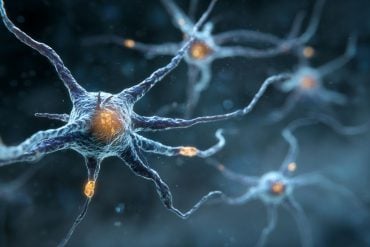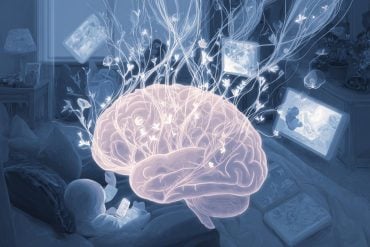Summary: Researchers have created a standardized mouse stem cell library containing 63 genetic variants strongly linked to autism spectrum disorder. Using CRISPR gene editing, the team generated mice and diverse tissues from these modified cells, allowing them to model autism at both the cellular and organismal level.
Analysis revealed that many autism-related mutations impair neurons’ ability to clear defective proteins, highlighting a possible shared mechanism. This cell bank is now a powerful, shareable resource for investigating autism and related neuropsychiatric conditions.
Key Facts:
- Cell Library Created: 63 genetically edited mouse stem cell lines linked to autism.
- Mechanism Identified: Mutations often impair neurons’ protein quality control.
- Broad Utility: Library supports research into autism, schizophrenia, and bipolar disorder.
Source: Kobe University
Although it is well understood that genetics influence the development of autism spectrum disorder, no one could yet pinpoint the precise cause and mechanism.
To study the biological background of diseases, researchers use models: Cell models allow us to study how changes in the genes affect the shape and function of the cell, while animal models show how the change in its cellular components affects health and behavior.

Despite significant differences between mice and humans, many disease-causing genes are very similar and cause similar conditions across these species.
“One of the problems, however, is the lack of a standardized biological model to study the effects of the different mutations associated with autism spectrum disorder. This makes it difficult to find out, for example, whether they have common effects or what is specific to certain cell types,” explains Kobe University neuroscientist TAKUMI Toru.
Thus, twelve years ago, Takumi and his team embarked on a journey to change that. Being experts in studying mouse models of the disorder, they combined a conventional manipulation technique for mouse embryonic stem cells — cells that can be made to develop into almost any kind of cell in the body — with the then-newly discovered, highly specific and easy-to-handle CRISPR gene editing system.
This new method proved highly efficient in making genetic variants of these cells and allowed the Kobe University team to produce a bank of 63 mouse embryonic stem cell lines of the genetic variants most strongly associated with autism spectrum disorder.
In the journal Cell Genomics, Takumi and his team now published that they were able to develop their cells into a broad range of cell types and tissues, and even generate adult mice with their genetic variations.
The analysis of these alone proved that their cell lines were adequate models for studying autism spectrum disorder. However, the cell lines also allowed them to conduct large-scale data analyses to clearly identify genes that are abnormally active, and in which cell types this is the case.
One of the things the data analysis brought to light is that autism-causing mutations often result in neurons being unable to eliminate misshapen proteins.
“This is particularly interesting since the local production of proteins is a unique feature in neurons, and a lack of quality control of these proteins may be a causal factor of neuronal defects,” explains Takumi.
The Kobe University neuroscientist expects that his team’s achievement, which has been made available to other researchers and can be flexibly integrated with other lab techniques and adjusted to other targets, will be an invaluable resource for the scientific community studying autism and trying to find drug targets.
He adds: “Interestingly, the genetic variants we studied are also implicated in other neuropsychiatric disorders such as schizophrenia and bipolar disorder. So, this library may be useful for studying other conditions as well.”
Funding: This research was funded by the Japan Society for the Promotion of Science (grants 16H06316, 16F16110, 21H00202, 21H04813, 23KK0132, 23H04233, 24H00620, 24H01241, 24K22036, 17K07119 and 21K07820), the Japan Agency for Medical Research and Development (grant JP21wm0425011), the Japan Science and Technology Agency (grants JPMJPF2018, JPMJMS2299 and JPMJMS229B), the National Center of Neurology and Psychiatry (grant 6-9), the Takeda Science Foundation, the Smoking Research Foundation, the Tokyo Biochemical Research Foundation, the Kawano Masanori Memorial Public Interest Incorporated Foundation for Promotion of Pediatrics, the Taiju Life Social Welfare Foundation, the Tokumori Yasumoto Memorial Trust for Researches on Tuberous Sclerosis Complex and Related Rare Neurological Diseases, and Takeda Pharmaceutical Company Ltd. It was conducted in collaboration with researchers from the RIKEN Center for Brain Science, Radboud University, the RIKEN Center for Integrative Medical Sciences, the Agency for Science, Technology and Research, the RIKEN Center for Biosystems Dynamics Research, and Hiroshima University.
About this genetics and Autism research news
Author: Daniel Schenz
Source: Kobe University
Contact: Daniel Schenz – Kobe University
Image: The image is credited to Neuroscience News
Original Research: Open access.
“ES cell models of autism with copy number variations reveal cell-type-specific translational vulnerability” by TAKUMI Toru et al. Cell Genomics
Abstract
ES cell models of autism with copy number variations reveal cell-type-specific translational vulnerability
Human genetics has identified numerous copy-number variations (CNVs) associated with autism spectrum disorders (ASDs).
However, the lack of standardized biological resources impedes understanding of the cell-type-specific common features of ASD.
Here, we establish a biological resource including 63 genetically modified mouse embryonic stem cell (ESC) lines as genetic models of ASD.
We perform neural differentiation using 12 representative cell lines, and their comprehensive analyses, including single-cell RNA sequencing, uncover cell-type-specific susceptible pathways.
Moreover, we find that a common phenotype in glutamatergic and GABAergic neurons is reduced expression of Upf3b, a core member of the translational termination and nonsense-mediated decay (NMD).
This finding emphasizes that the dysfunction of translational machinery in the developing neurons can be a possible target of early intervention for ASD.
This ESC model bank becomes an invaluable resource for studies in vitro and in vivo of ASD or other neuropsychiatric disorders.






